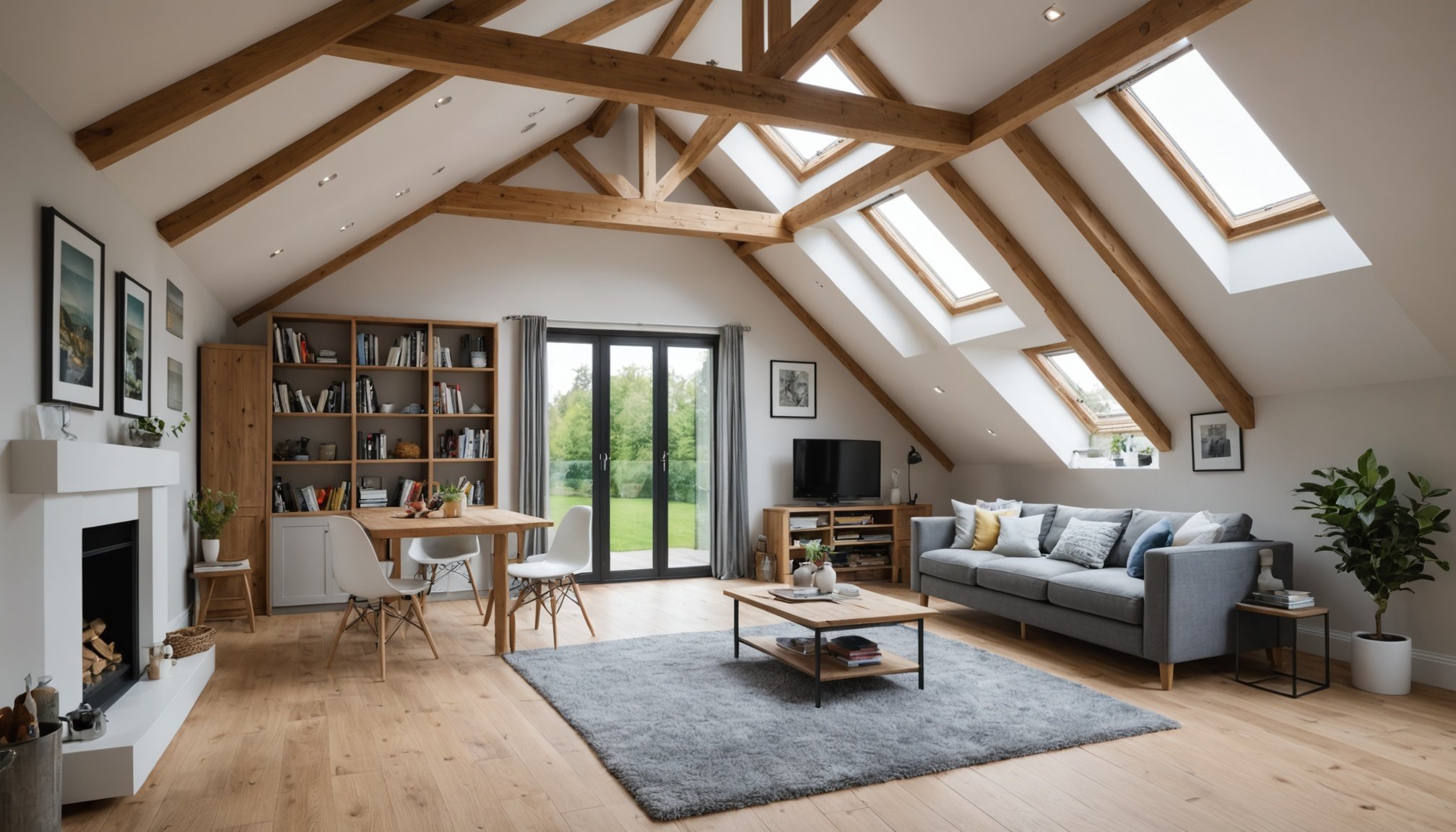Overview of Mezzanine Floors in Loft Conversions
Mezzanine floors are a popular enhancement in loft conversions, transforming underutilised spaces into functional areas. In the UK, a mezzanine is a partial floor that doesn’t cover the entire loft, maximising both space efficiency and aesthetic appeal in residential buildings. It offers a practical solution to house owners who seek to optimise their living areas.
The primary benefit of mezzanine floors lies in their ability to create additional space without the need for extensive structural changes. Instead of constructing an entirely new floor, a mezzanine makes use of the available vertical space, often with striking architectural results. This can significantly enhance a home’s value while offering residents an elegant solution for various needs, like a new bedroom, office, or play area.
Have you seen this : Brightening Up: Innovative Strategies to Maximize Natural Light in Your UK Basement Conversion
Mezzanine floors also shine in their ability to complement the design advantages of loft conversions. They seamlessly integrate with existing structures, providing a minimalist and open feel that can make spaces appear more expansive and inviting. Exploring illustrated case studies of successful mezzanine integrations reveals how different design choices can align with specific homeowner requirements, offering both function and style.
Planning Your Mezzanine Addition
When embarking on the planning process for a mezzanine addition, one must first appreciate the importance of pre-planning and conducting a thorough structural assessment. This initial evaluation helps determine the feasibility of adding a mezzanine based on your existing space and its structural capabilities. Identifying potential solutions for any constraints early on can save time and resources later in the project.
This might interest you : Essential Components for Crafting a Genuine Coastal Bathroom Inspired by the UK
Key design considerations include defining the dimensions and selecting appropriate materials. Consider the intended use of the mezzanine when choosing materials, as this will influence both aesthetics and functionality. Balancing these aspects with budgetary constraints and space limitations is crucial to create a harmonious extension that meets your needs.
Understanding and navigating regulatory requirements is vital. UK building regulations for loft conversions stipulate factors such as headroom clearance, fire safety measures, and staircase accessibility. Compliance with these laws not only ensures safety but also streamlines the approval process. Having a grasp of these regulations before you start can prevent unnecessary delays and complications.
In summary, an informed approach to the mezzanine addition planning process, with careful attention paid to design and regulatory aspects, paves the way for a successful project.
Legal and Regulatory Requirements
Understanding legal compliance for constructing mezzanines in the UK is crucial. You must ensure that your project adheres to UK building regulations and planning permission guidelines.
Planning Permission Requirements
When considering the installation of a mezzanine, assessing whether planning permission is needed is essential. Typically, planning permission isn’t required for mezzanine structures utilized for storage or similar purposes. However, if the mezzanine impacts the external appearance of a building or is intended for office use, permission might be mandatory.
Building Regulations for Mezzanines
Building regulations focus on safety and structural integrity. These regulations address aspects such as fire safety, load-bearing capacity, and access routes. Consulting with local authorities ensures that your mezzanine complies with these essential standards. Adherence to these guidelines not only assures safety but also helps in avoiding potential legal issues.
Importance of Professional Consultation
Consult with professionals and local authorities early in your project planning. They can provide guidance on both planning permission and regulations. This proactive approach helps in understanding the full scope of legal and regulatory requirements, ensuring legal compliance and a smoother construction process. By engaging with experts, you gain clarity on these often complex processes.
Cost Estimates for Adding a Mezzanine
Adding a mezzanine can be an effective way to maximise space, but understanding the necessary cost breakdown is crucial. Typically, the expenses involved include three key elements: materials, labour, and permits.
Materials play a vital role in the overall cost. Depending on the structural requirements and finishes you desire, prices can vary widely. Steel, wood, and concrete are common choices, each with its associated costs. Budgeting for high-quality materials can ensure longevity and safety of your mezzanine.
Labour costs depend on the complexity and size of the project. Hiring skilled workers may increase expenses, but their expertise is invaluable for smooth installation. Factors like design, engineering needs, and installation time all influence labour costs.
Don’t overlook permits. Local regulations often require permits, adding to your financial considerations. These permits ensure your mezzanine meets safety standards and building codes.
To obtain accurate quotes, communicate clearly with contractors. Provide specific details about your vision and requirements. Request itemised breakdowns to understand the cost breakdown thoroughly. This transparency not only aids budgeting but also highlights any potential hidden costs.
Design Tips for an Ideal Mezzanine
Incorporating a mezzanine into your home is an exciting way to unlock additional space while injecting a dose of design inspiration into your interior. Starting with creative design ideas, consider how you can maximise space and usability. Think vertically; use space-saving solutions like slide-out storage and staircases with built-in shelves to enhance functionality without compromising on aesthetics.
Natural light and ventilation play a crucial role in mezzanine design. The sense of space can be significantly improved with skylights, high windows, or glass walls to invite natural light to every corner. Effective ventilation ensures the interior design remains comfortable, so consider installing operable windows or incorporating fan systems to encourage airflow.
A functional layout hinges on thoughtful furniture choices. For limited areas, opt for multifunctional furniture such as sofa beds or foldable tables which cater to versatile uses. Ensure walking paths remain clear by arranging furniture strategically, allowing ease of movement.
Keep in mind these crucial elements when designing a mezzanine, ensuring every inch serves a purpose while maintaining an inviting atmosphere. Creating a balanced blend of functionality and aesthetics will not only enhance your living space but also reflect inspired interior design choices.
Challenges and Common Mistakes
Adding an extension can be daunting, with various potential challenges arising if not approached carefully. One common error is underestimating the project’s complexity, leading to unforeseen setbacks. Many assume that a straightforward design equals straightforward execution, but this isn’t always the case. To mitigate the risk of project pitfalls, it’s crucial to anticipate potential issues from the outset.
Failure to address structural integrity is another frequent misstep. Often, people neglect to consider how the new addition will affect their home’s existing structure, risking serious damage. Seeking expert consultation early in the planning stage can prevent costly repairs and common errors down the line.
Another overlooked area is budgeting. It’s a potential challenge when unexpected expenses crop up due to insufficient planning. A detailed financial plan, accounting for contingencies, helps maintain control over costs and keep the project on track.
Thorough planning is indispensable in avoiding pitfalls. Conducting comprehensive research, consulting with professionals, and creating a detailed project plan can significantly reduce risks. A well-considered approach, attentive to detail, ensures that your project not only meets your expectations but also enhances the value of your home.
Frequently Asked Questions about Mezzanine Conversions
Exploring mezzanine conversions often comes with a plethora of FAQs and common concerns. Here, we address some of the prevalent questions and provide expert advice to ease the process.
What are the main advantages of adding a mezzanine?
The primary advantage of mezzanine additions is the creation of extra floor space without the need for extensive construction. This is cost-effective and typically requires less time compared to building a new structure. This added space can serve as additional storage, office space, or facilitate better organisation.
Are there regulations and costs associated with mezzanine conversions?
Yes, understanding the local regulations and anticipated costs is crucial. Some common concerns include building permits, safety codes, and potential zoning restrictions. Regulations can vary significantly, so consulting with local professionals is recommended. Costs, while generally lower than new builds, can fluctuate based on factors like materials and design complexity.
What tips do experts offer for a successful project?
Experts suggest meticulous planning and consultation with experienced contractors. It’s vital to consider load-bearing capacity, access points, and intended use in the design phase. Ensuring compliance with safety standards and maintaining communication with regulatory bodies will also contribute to a successful conversion.











